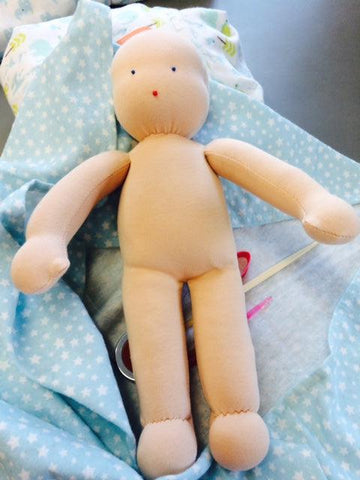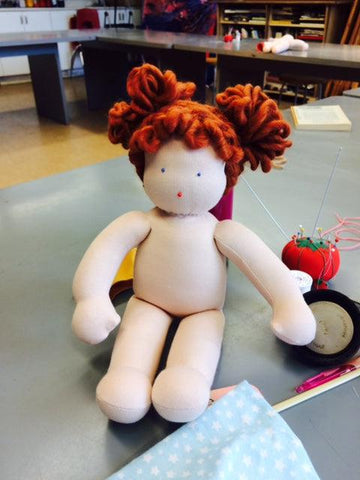In Our Image: Why Make a “Waldorf” Doll? August 21 2015
Waldorf dolls, like many toys used in Waldorf classrooms, are handmade using natural materials and are very simple in appearance. Designed to encourage and stimulate a child’s imagination the doll’s simple expression easily reflects the child’s mood and creativity. This is one doll maker’s account of the magical process of making a Waldorf doll.

The Doll making workshop started with introductions and an explanation from the teacher of how important making a doll is. The image of the human being – well, of any living thing, really – is a sacred thing. “What a piece of work is a man,” said Hamlet in Shakespeare’s play of the same name, while he pondered how many mistakes man can make even endowed with such proportion and potential in shape and function as he is.
It is astonishing to realize the proportions of the human form and to consider how it changes. These changes were the topic of developing our intentions around the doll we were about to make. How old would the doll be? A very young doll would have a head that might be about one-fourth the size of the whole length of the doll. If our doll were to be older, the head would be slightly smaller in proportion to the whole form of the human figure. Once a human being is fully-grown, the final ratio is 1:7. It’s humbling to think about the transformation that a human body accomplishes in the steady development from birth to full maturity.
Doing this exercise with the teacher was as it is in observing child development as a Waldorf teacher. Not every child is the same as any other. Likewise no handmade doll is the same as any other. This is one reason why it is so thrilling to make a doll. As with children, one really can’t predict how it’s going to come out. But one can dream and imagine and plan.
When one makes something for a child by hand, it is imbued with the warmth of the creator. It is filled with the good intentions toward the child that the hand maker thought and felt during creation. The child is surrounded then with these good thoughts, these friendly and loving wishes for the child.
When the class made its decisions about how to begin, the teacher led us through step by careful step. She had done a great deal of preparation for the workshop so that all participants had a hope of completing the doll in the week we had, two and a half hours a day. Alone, the doll makers would have had to spend much more time than the hours we spent. Fifteen to twenty-four hours is a usual amount and in the course of ordinary life, these would not be concentrated as in the workshop on doll making was. Life would interrupt…the very child for whom the doll was being made would interrupt!! So the whole process could take many weeks.
Once the work began there were long quiet stretches of time during which all were working in steady concentration. It takes a firm will and committed determination to make a doll and see it through to completion. This becomes another gift for a child that is woven into the substance of the doll: a strong will to work until a task is done.

Many shared stories of having made a doll for a little child. Several had the experience of an eighteen-month-old snatching the head and whisking it off to a hiding place where it could be held and played with. The poor doll maker is left trying to win at hide-and-seek with the doll that as yet has no more than a head and the rudimentary beginnings of a torso. Before it is even born completely, the child already loves it and wants to have it and play with it!
During the process of developing the doll, much hand sewing is needed and this hand sewing requires intense effort in some cases. Pulling out and trying again was shared in the workshop. Tips on how to “get it just right” were shared by the teacher and by participants who had discovered something in doing it themselves. One doll making workshop participant was visiting from the Middle East. She took out the embroidery for the eyes at least four times before she was satisfied that the doll’s face was as it should be. This exactness and commitment to detail is now in her doll and will be in the hands of the child who receives her doll.

Making the hair of the doll was a particularly challenging and rewarding procedure. This part of making a doll takes a long time. The teacher suggested some “short cut” methods but even these were not so short. The difference in the doll once hair was in place was the biggest miracle of all. The personality of the little doll came rushing out through the make of the hair. Laughter and unmitigated delight followed the presentation of each doll’s completed hair. Color, style, density, placement, and gesture of the hair on each doll presented a remarkable surprise. It was irresistible to feel character behind this step on every doll.
Tiny hints of a mouth and eyes, leaving the doll free to have a child decide how the dolly is feeling – happy, or sad or angry – and not fixing the doll’s face with a big smile or an eternal simper – was the next miracle step of the many in forming the dolls. Something so human and enticing appeared when the features were on the faces of the baby dolls.

As the dolls grew more complete, there were many quips among participants about “birthing” the doll. All participants were parents and all knew the effort needed to conceive, grow and birth a little one. There was humorous reference to how much easier, cleaner less painful than real birth the “birthing of a doll” is. When one doll maker or another would cry out that some part of the getting the doll done was difficult, someone else would remark that, yes, difficult, but nothing compared to a real birth.
Through this banter, we shared birth stories and acknowledged this more serious side of doll making: that the form represents the glory of the human form, and the rightness of this form helps the child who receives the doll to see itself in an ideal form in the doll. The teacher spoke of dolls that are caricatures of real human beings: Eyes deliberately too close or too far apart, a fixed expression that dramatizes cheerfulness or sorrow, limbs that are exaggeratedly long or short for cuteness’s sake. These do not help the child realize the perfection of the human form in the same way.
There was, therefore, in the workshop an underlying reverence in understanding how remarkable is the human form. The children who receive such a doll receive all these things experienced in making the doll: commitment; determination; care; assessment; error and correction; joy; flagging spirits and encouragement; exacting discernment; and love – imagining the child who might have the doll and what the reaction to it might be.

Making a doll is a gift to the maker and to the child who receives it; as the workshop was a gift from the teacher to the participants. Once all the babies were “born” in the class a final picture of all the makers and the made dolls. It is a picture of delight and appropriate pride and feelings of accomplishment.
It’s hard to imagine a finer gift for a little one to receive for playing out the variations in life, the ideas of friendship with another being, en-souled by the love of the child. A friend with the very substance of the hand maker is a solid friend to have in any situation in a young life.
